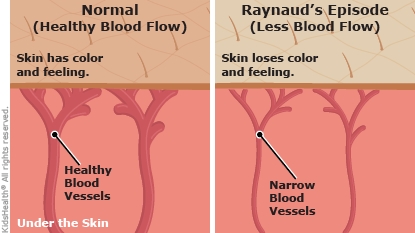Raynaud's Syndrome: How to Care for Your Child
Raynaud's syndrome causes a person's fingers or toes to temporarily feel cold, numb, tingly or painful. In a Raynaud's episode, the blood vessels become narrow and less blood gets to the affected area. Often, the skin will:
-
get very pale or white
-
turn bluish or purplish
-
look rosy or red as the person starts warming up
Exposure to cold or to emotional stress can trigger an episode.


-
If the health care provider prescribed medicine, give it as directed.
-
Prepare for the weather:
-
When it's cold outside, have your child wear warm, loose layers; thick socks; a hat; gloves or mittens (note: mittens help keep fingers warmer).
-
In warm weather, your child should have a sweater or jacket available to wear in air-conditioned places.
-
Encourage your child to get exercise, which can help with circulation.
-
To warm fingers or toes during a Raynaud's episode, your child can:
-
Move to a warmer location.
-
Swing arms in circles.
-
Wiggle fingers or toes.
-
Place hands or feet in warm (not hot) water.
-
Place hands against a warm part of the body (such as the armpits).
-
Rub hands together or massage the feet.
-
Avoid things ("triggers") that can make Raynaud's worse, such as:
-
smoking and secondhand smoke
-
caffeine
-
stress (relaxation exercises can be helpful)
-
tight-fitting rings, bracelets or shoes, since these can make it harder for blood to get through the blood vessels in the area
-
some medicines that narrow the blood vessels

Your child:
-
has symptoms that get worse
-
has a Raynaud's episode that does not improve within 20 minutes of warming up and relaxing
-
has a sore on a finger or toe
-
gets a rash, fever or joint pain


Does a person with Raynaud's always have the same skin color-changing pattern? No. The skin typically changes from white to blue/purple to red. But in some kids, all these colors may not happen, or the color changes may happen in a different order.
What other parts of the body can Raynaud's affect? Raynaud's syndrome usually affects fingers and toes, but occasionally it can affect the nose, ears, lips, nipples or knees.
How long does a Raynaud's episode usually last? An episode usually will last for as long as the trigger is present. It can take about 15 minutes to go away after that.